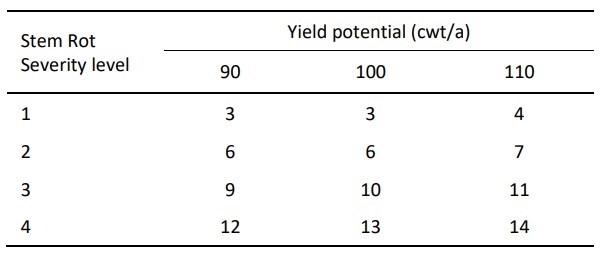Stem rot is a common disease of rice that can cause blanking and lodging. When the disease is severe, the presence and effects of the disease on yield can be obvious. However, at lower levels, the symptoms and effects of the disease may “fly under the radar”.
Stem rot affects the tillers at the water level. Mid season, small black lesions appear on lower leaf sheaths. As the disease progresses, the pathogen penetrates the tiller and can reach the culm, causing rot. These symptoms are most obvious when fields are drained for harvest. Once plants start to senesce, it can be difficult to identify stem rot symptoms because plants dry out.
The severity of stem rot is determined at drain time using a ranking that goes from 0 (no disease) to 4 (tillers rotted through). Several years of trials have shown that for each increase in severity level, there is a 3.2% yield loss. The table below shows the yield losses that can be expected under each severity level for three different yield potentials.
- 50% of tillers show stem rot symptoms = Severity level 1
- 100% of tillers show stem rot symptoms = Severity level 2 or higher
Yield losses at severity level 2 could be significant, so a manager should aim to be below this disease level. To determine incidence at drain time, cut a handful of tillers at the soil level and determine how many show symptoms of stem rot. Do this at several representative places in the field, avoiding nitrogen overlaps or skips, until you feel you have a good estimate.
The second challenge is that evaluating the severity of stem rot at drain time provides information that cannot be used to make any management actions the current year. However, the information can be used to plan management for the following year. Because stem rot inoculum survives in crop residue in the soil, disease severity levels tend to be uniform across years.
To manage stem rot, an integrated approach is needed. Managing straw after harvest is key. Burning or decomposing straw aids in reducing the amount of inoculum that survives from year to year. Excess nitrogen and potassium deficiency can significantly increase the severity of the disease. While there are no resistant varieties, very early varieties (CM-101, M-105) tend to develop more severe stem rot that varieties with longer cycles (M-209, M-211). Finally, fungicides can help manage the disease. Azoxystrobin applied at the early heading stage has been shown to reduce the severity of the disease by 30%.
Survey: Challenges and Opportunities for Organic Rice
In the next few weeks, you will receive an email with a link to a survey being conducted as part of a project looking at the attitudes of rice producers towards organic farming. This project is trying to understand what drives US rice producers to adopt organic farming and what factors limit adoption, and is a collaboration between University of Arkansas, Texas A&M University, and University of California Cooperative Extension. The information generated by the project can help the industry identify adoption barriers and try to address them through policy and extension, so that organic production can become a viable option for more producers. The survey should take 15-20 minutes to complete. You can learn more about this project at The Organic Center website (https://organic-center.org/site/challenges-and-opportunities-us-organic-rice)
